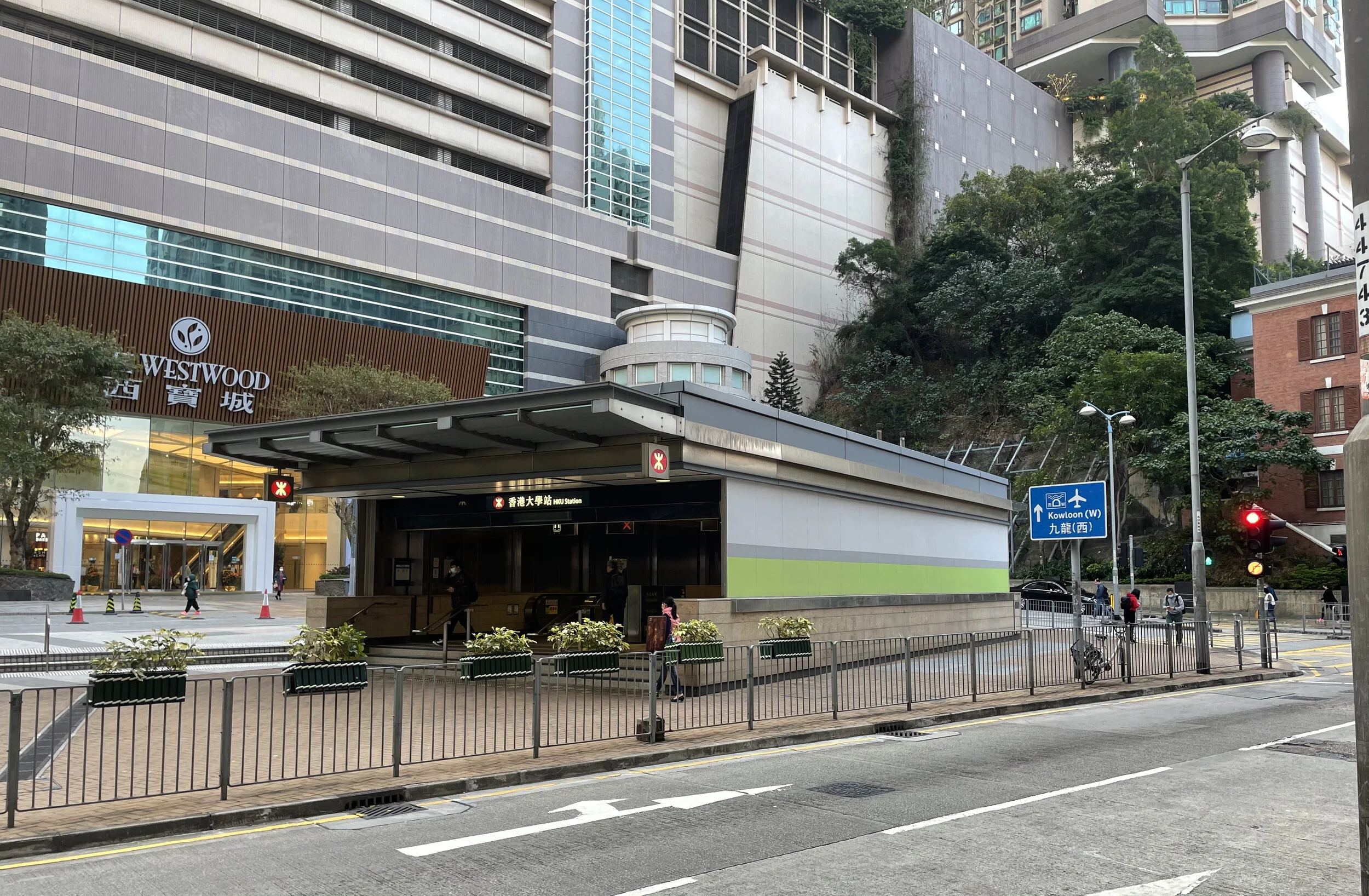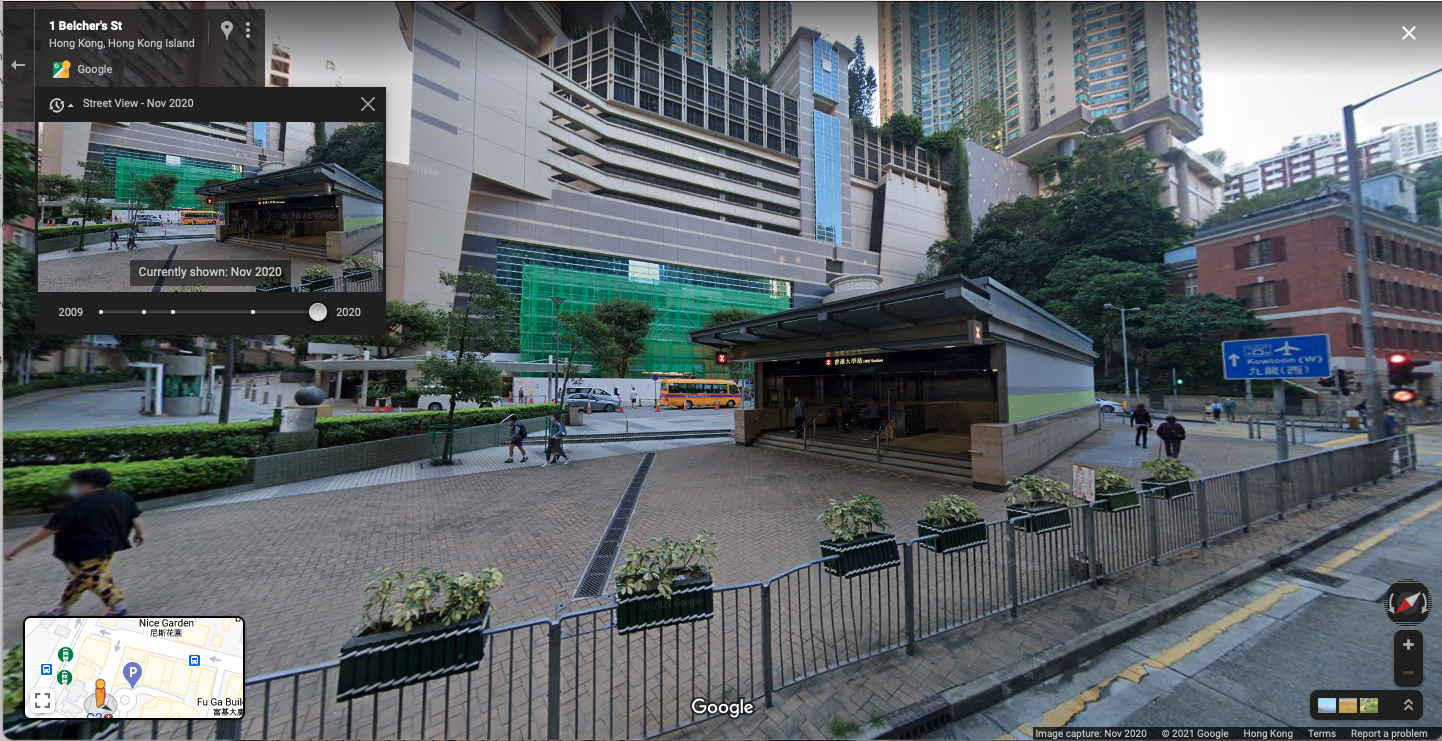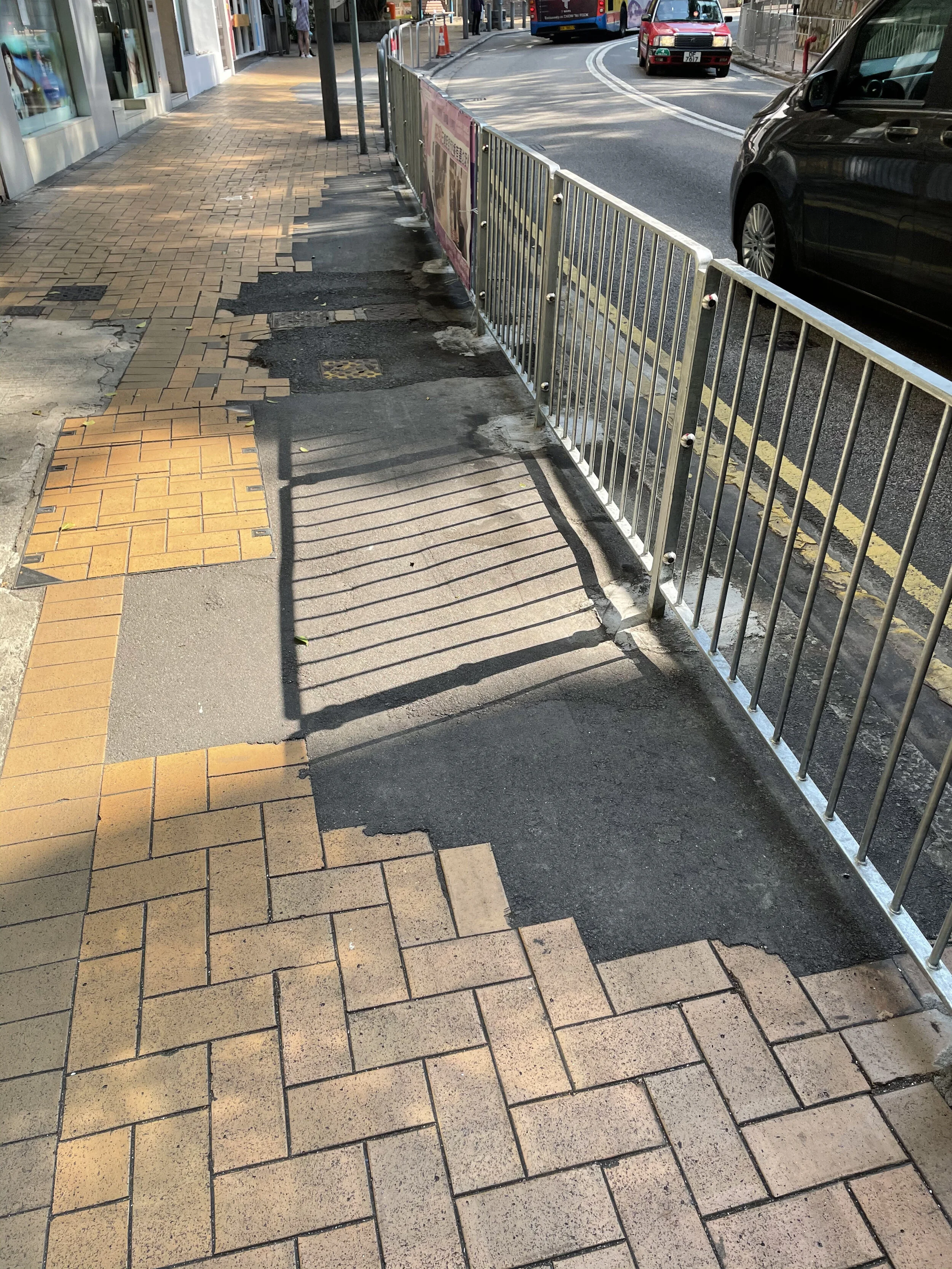Traces of Protest and Curb-Scale Infrastructures in Hong Kong
Sometime in 2019 at the university where I teach in Hong Kong, students began a Lennon Wall. The wall took shape alongside University Street, a pedestrian walkway pinned onto the hillside that linked campus buildings to a public entrance of the Mass Transit Railway (MTR). Like Lennon Walls all over the city, this one was covered with post-its, printed sheets of paper, posters, objects, and painted words. Messages were directed toward government policies and the university administration.
The wall stayed up long after others had been scrubbed. It was only in the fall of 2020, with the National Security Law several months in place, that the administration took everything down. Immediately after this tidying up, the length of University Street near the MTR entrance was blocked with water-filled barricades. These barriers are everywhere now—cordoning off police stations, banks, and some government buildings. There is a photograph circulating on social media of water emptying in a thin arc from one such barricade; someone had pierced a small hole into its thick plastic wall (Figure 1).
Figure 1. Water-filled barricades outside of the old Bank of China building on Queen’s Road Central. Photograph by Sony Devabhaktuni, 2020.
More recently, the university administration replaced the barricades with vertical panels of planting: a green wall (Figure 2). All of this has taken place with seemingly little consequence, as if each transformation were no more or less meaningful than the last. Maybe it is difficult to register the meanings of these changes because they are part of an onslaught of signs, edicts, and harbingers that seem to arrive from all directions. This is in addition to each new “super-spreader” event and “ambush lockdown” that distracts from the ways in which the city’s recent past has been subdued with the unremitting force of denial.
Figure 2. The new green wall on University Street. Photograph by Sony Devabhaktuni, 2021.
Yet unremarkable changes to the physical infrastructure of the city persist in surprising ways. In ordinary times, these traces—details at the scale of cladding or the curb—go unnoticed. Their relative invisibility belies the impact they have on the public realm, both for the qualitative difference they produce and the more subtle ways in which they figure the authority charged with its upholding.
From the University Street MTR entrance, it is possible to take elevators that descend into a network of tunnels, so that you emerge hundreds of meters away not far from Victoria Harbor. Here a free-standing exit––once enclosed on three sides by glass––is now armored in metal sheet. Taking the escalator from the depths of the station, what was once an ascent into city light, remains darkened until the very last moment. Similar, free-standing exits are common in new parts of the MTR system. They are sometimes in the middle of public spaces cleared by the demolition of older buildings. Despite being penned in by towers, the small spaces offer valuable places to stop. Where before light and views passed into and through the free-standing exits, the steel cladding has transformed them into squat bunkers (Figures 3, 4 and 5).
Figure 3. HKU MTR Station Exit C2 with steel sheet cladding. Photograph by Sony Devabhaktuni, 2020.
Figure 4. HKU MTR Station Exit C2, January 2017. Courtesy Street View by Google.
Figure 5. HKU MTR Station Exit C2, November 2020. Courtesy Street View by Google.
The company that manages the MTR has also replaced glass with steel sheet in the railing of walkways tens of meters in the air, and in overhead canopies. Protestors shattered these partitions in several stations, dismantling an uneasy entanglement of transparency, vision, and security. The opaque sheet does away with these ambiguities and describes a civic space that is un-questionably safe and controlled.
In other parts of the city, chain-link fence now encloses pedestrian bridges to enforce this new formula of authority. These bridges sometimes served as staging grounds for protestors to throw objects onto traffic, and other times for armed police to survey crowds. The new layer of fencing rises the full height of the bridges and was jerry-rigged into place, the chain link slipped between an outer balustrade and an inner handrail. It is fixed in place with a thin metal strip screwed to existing vertical elements. The cage-like quality of the bridges at first does not register. “Was it always like this? Or am I seeing differently?”
Figure 6. Dismantled brick pavement in November 2019. Photograph by Sony Devabhaktuni.
Figure 7. Quickly restored sidewalks, with vertical pedestrian fence elements linked with construction tape. Photograph by Sony Devabhaktuni, 2019.
More noticeable during the protests were the pedestrian fences detached from sidewalks. These fences line hundreds of kilometers of Hong Kong’s roads and are set back from the edge of the curb, corralling people into sometimes already cramped walkways. Despite experiments in other cities that showed how removing these barricades does not increase traffic accidents, the Transport Department continues to delimit sidewalks in the name of safety. Protestors dismantled approximately fifty kilometers of fencing using a simple flat wrench. For weeks afterwards, sidewalks all over the city were free of the fences (Figure 6). Where denuded vertical posts remained, the Transport Department quickly strung red police tape. Then bright red plastic chain was knotted around the bare verticals and secured with clips into existing screw holes (Figure 7). This was the first sign that newly liberated street would not last. And soon, shiny new modules replaced what had been dismantled. The new barriers comprised a higher grade of steel and were joined to posts by stiffened bolts recessed into a raised circular head. Where the posts themselves had been dislodged from the earth, steel plate was added to concrete footings (Figure 8).
Figure 8. Dismantled pedestrian fences; in the background is MTR entrance whose glass canopy has been shattered. Photograph by Sony Devabhaktuni, 2019.
Figure 9. Plastic chain linked vertical fence posts for several months in parts of the city. Photograph by Sony Devabhaktuni, 2020.
The pulling of fence posts also loosened bricks from sidewalks (Figure 9). Protestors positioned them on streets in fields of arches, menhirs, stacks, and mounds. These bricks are ochre red in their most standard form; similar ones are used on University Street. Unless a developer has introduced a signature material in front of a new construction, they are they default pavers for sidewalks. The bricks are placed on a coarse bed of sand and dirt, so that they can be easily dug up to access the networks running underneath. Typhoon rains and growing roots often deform the checkered brick surfaces, leaving pools of rainwater and making walking treacherous.
Where large sections of sidewalks were undone, workers quickly filled gaps with poured concrete or bitumen, leaving rough or smooth splotches edged by the remaining bricks (Figure 10). It seems unlikely, with the time that has gone by, that the Highways Department will invest in redoing these surfaces, each with their own mini topology.
Figure 10. New fencing fixed with anti-theft bolts. Photograph by Sony Devabhaktuni, 2020.
These curb-scale infrastructures are the results of meetings, decisions, and sometimes drawings. They, in turn, enforce policies and priorities. In ordinary times we can examine them to ask about structures of governance and the values placed on the public realm. These days in Hong Kong, this curb-scale speaks as well about the very quick way in which the city was put back into place after the protests––with tens of millions of dollars spent to restore its functioning with a silent and undeliberated efficiency. That work coincided with COVID-19’s refiguring of government authority and culminated with the National Security Law and its ongoing articulation into public life. These numbing shocks make the physical changes left behind by events of the recent past even sharper––more cutting. They mark a relief of traces and suggest ways in which a close attention to the curb-scale can offer readings of cities.









